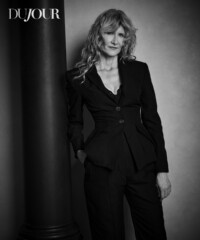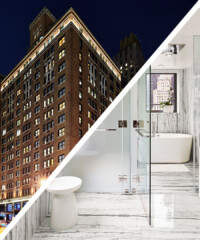Lawrence Wright walked to the bottom of his driveway in Austin, Texas, on the morning of January 16, 2015, and picked up the New York Times. In 2013, the Pulitzer winner had made his second appearance on the Times’ best-seller list with Going Clear: Scientology, Hollywood & the Prison of Belief, a 448-page probe into the Church of Scientology. Today, Wright’s name was in the paper for a related reason: a full-page advertisement in the A section assailing Going Clear for relying on sources the ad claimed were prone to “malfeasance, lying, and conduct unbecoming a Church member.”
This messaging had the appearance of a preemptive strike against filmmaker Alex Gibney’s then-forthcoming HBO documentary Going Clear: Scientology and the Prison of Belief, which is based on Wright’s book. The ad dovetailed with a Twitter campaign, Google ads and, on the day of Going Clear’s March premiere, a letter to The Hollywood Reporter slamming Gibney’s “bigoted propaganda piece” and accusing Wright of “suffering from an acute case of jealousy” of the religion’s founder, L. Ron Hubbard.
This wasn’t new for Wright. In August 2011, six months after the publication of his New Yorker profile of defector Paul Haggis, Scientologists arrived outside the magazine’s Manhattan headquarters to hand out copies of Freedom, a Church publication that had fashioned its latest issue into a 51-page parody of the illustrious weekly. A Freedom reporter has since shown up to events where Wright is appearing, attempting to interview him. The threat of litigation has loomed over the past five years, and as this article was being put to bed, just ahead of Going Clear’s release, lawyers for Wright, Gibney and HBO were ready for what could be a fight.

Filmmaker Alex Gibney
The hubbub around Going Clear reflects the often fiery dynamic between journalists and alleged cults, some of which employ an approach to media relations that involves smears, intimidation and legal threats.
Scientology, which has faced scrutiny over alleged abuses within its ranks, is notorious for tangling with the press. Paulette Cooper, a journalist who took on the Church in the 1970s, was subjected to lawsuits and harassment—including being framed for a bomb threat—that Scientology brass now dismisses as “ancient history.” Another disturbing anecdote: In 1985, a Los Angeles Times reporter suspected members in the poisoning of his dog, something the Church denies. (“We like pets,” a spokesperson tells DuJour.) As Tony Ortega, whose book on Cooper and her battle with the Church is due out this spring, says, “No one fights journalists like Scientology.”
The Church of Scientology is the group best known for waging media wars, but it isn’t alone—and it’s not the only organization that attracts the rich and powerful. At press time, Vanity Fair contributing editor Suzanna Andrews and Albany Times Union reporter James Odato were battling a lawsuit from NXIVM (pronounced “Nexium,” like the heartburn medicine), an upstate New York personal-development corporation that has been in the spotlight thanks to the group’s founder—entrepreneur and self-improvement guru Keith Raniere—as well as ties to figures including Seagram’s heiresses Sara and Clare Bronfman and Richard Branson.
Journalists had entered NXIVM’s crosshairs before. In 2009, NXIVM sued the newsweekly Metroland for $65 million, alleging the publication conspired with Rick Ross, an anti-cult figure quoted in a 2008 article, to promote false information. (The case never went to trial.) The following year, Vanity Fair published “The Heiresses and the Cult,” Andrews’ look into the Bronfman sisters’ involvement with and reportedly significant investment in NXIVM. In 2012, the Times Union ran Odato’s four-part investigative series, “Secrets of NXIVM.”
In a legal action filed in October 2013, NXIVM alleged that Andrews, Odato and several others illegally accessed NXIVM’s computer server by using login information provided by a former client. “Its chilling effects have already been felt,” William D. Cohan wrote in The Nation. “Journalists generally have stopped writing about the strange doings at NXIVM.” Andrews’ attorney declined to make her available; Odato declined to comment.
“This is not about retaliation,” NXIVM’s lawyer, Martin D. Singer, tells DuJour. “This is about reporters trying to use the First Amendment as a shield. . . . NXIVM is not looking to exact revenge on these reporters, or to silence the press.”

Sara and Clare Bronfman
Still, this kind of back and forth is nothing new. In 1981, the Unification Church of Rev. Sun Myung Moon lost a suit against London’s Daily Mail over an article titled “The Church That Breaks Up Families.” Around the same time in Northern California, the Point Reyes Light grappled with intimidation from Synanon as the paper published stories about the group that would eventually win a Pulitzer Prize. (Originally a drug-rehab program, Synanon became known for violent behavior and criminal activity, including attempted murder by rattlesnake.) Throughout the late 1970s and early 1980s, Synanon sued everyone from Reader’s Digest to Time, a strategy that “intimidated much of the mass media on the West Coast into being silent,” as a 1985 Palm Beach Post op-ed put it. (Discredited and financially drained, Synanon disbanded in 1989.)
Perhaps the mother of all media battles was Scientology’s $416 million libel lawsuit against Time for Richard Behar’s 1991 article, “The Thriving Cult of Greed and Power,” which painted the church as “Mafia-like.” Ten years and countless billable hours later, Time won a legal victory when a federal appellate judge upheld the magazine’s assessment. The Church says it hasn’t filed a defamation claim since.
For its part, Scientology doesn’t see its maneuvers as aggressive media tactics so much as “speaking out when treated unfairly,” as spokeswoman Karin Pouw puts it. The Church believes its relationship with the media has improved, Pouw tells DuJour. “There are thousands of articles about Scientology” in any given year, she says, most of which “pass without comment.”
As for Going Clear, it’s up to viewers to decide whether the reporting was driven by a “small fringe group,” according to Pouw, of ax-grinding apostates, or if Wright and Gibney are highlighting the stories of courageous whistle-blowers. At the heart of the disconnect: Gibney says the Church declined to grant access to the Scientology figures he wanted to interview; the Church, meanwhile, sent to Gibney’s New York office 25 people it says are ex-spouses, children and former colleagues of the film’s subjects, but Gibney declined to interview them because he says they arrived unannounced long after his initial requests. Besides, Gibney says the point of Going Clear was to tell “the story of a few ex-Scientologists. I didn’t set out to make an all-inclusive film on the subject of Scientology.”
A 1988 study found that coverage of groups like Scientology simply “moved from one controversy to the next.” Indeed, adherents of the Church, Synanon and NXIVM would no doubt argue that the media has been unfair to them, missing the bigger story by focusing only on lurid and sensational elements.
Wright doesn’t see it that way. “It’s true of Scientology that reporters have cut a wide berth around it because of its reputation of persecuting people who’ve inquired about the Church,” he says. “My feeling is, when dealing with these types of organizations, they feel entitled to behave in the way they do because of their beliefs. Whenever there’s an organization that believes so strongly in its mission, it decides the ends justify the means.”









































